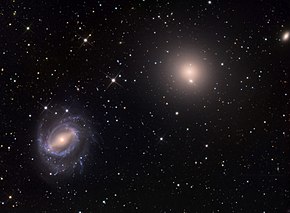| NGC 5846 | |
|---|---|
 NGC 5846 (right) and NGC 5850 (left) by the Schulman Telescope at Mount Lemmon SkyCenter | |
| Observation data (J2000 epoch) | |
| Constellation | Virgo |
| Right ascension | 15h 06m 29.3s[1] |
| Declination | +01° 36′ 20″[1] |
| Redshift | 0.005711 ± 0.000017 [1] |
| Heliocentric radial velocity | 1,712 ± 5 km/s[1] |
| Distance | 93 ± 32 Mly (28.5 ± 9.8 Mpc)[1] |
| Apparent magnitude (V) | 10.1 [2] |
| Characteristics | |
| Type | E0-1 [1] |
| Apparent size (V) | 4′.1 × 3′.8 |
| Notable features | Strong X-ray source |
| Other designations | |
| UGC 9706, CGCG 020-061, MCG +00-38-025, PGC 53932[1] | |
Preview warning: Page using Template:Infobox galaxy with unknown parameter "image_size"
Preview warning: Page using Template:Infobox galaxy with unknown parameter "credit"
NGC 5846 is an elliptical galaxy located in the constellation Virgo. It is located at a distance of circa 90 million light years from Earth, which, given its apparent dimensions, means that NGC 5846 is about 110,000 light years across. It was discovered by William Herschel on February 24, 1786.[3] It lies near 110 Virginis and is part of the Herschel 400 Catalogue.[4] It is a member of the NGC 5846 Group of galaxies, itself one of the Virgo III Groups strung out to the east of the Virgo Supercluster of galaxies.[5]
- ^ a b c d e f g "NASA/IPAC Extragalactic Database". Results for NGC 5846. Retrieved 2016-01-18.
- ^ "Revised NGC Data for NGC 5846". spider.seds.org. Retrieved 25 November 2018.
- ^ Seligman, Courtney. "NGC 5846 (= PGC 42734)". Celestial Atlas. Retrieved 19 November 2018.
- ^ O'Meara, Steve (2007). Herschel 400 Observing Guide. Cambridge University Press. p. 205. ISBN 9780521858939.
- ^ "The Virgo III Groups". Atlas of the Universe. Retrieved 2010-11-27.